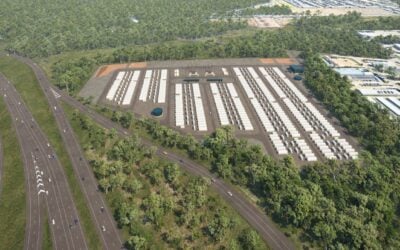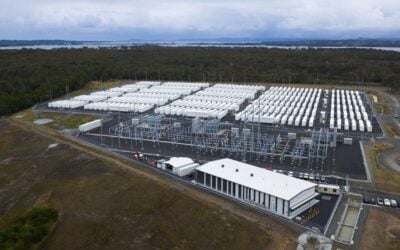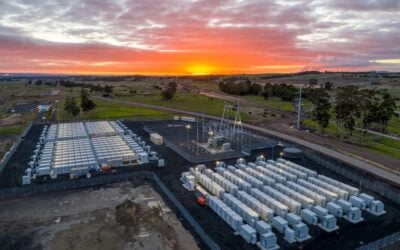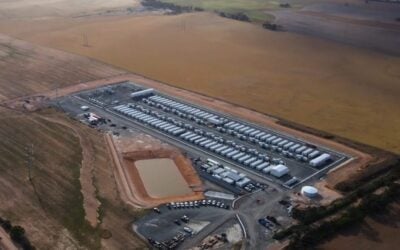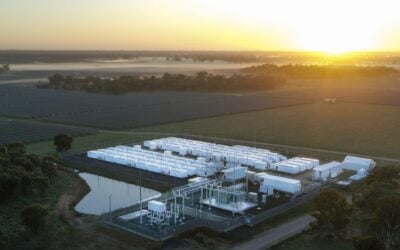Developer Belectric has connected an energy storage system at a large-scale solar power plant in Germany, which will be the first in Europe to operate on the primary operating reserve market.
The Alt Daber PV plant, on a former military airfield in Brandenburg, northern Germany, has a nameplate capacity of 67.8MW and was completed in 2011. The addition of the 2,000kWh lead-acid battery system, Energy Buffer Unit, was announced in February this year.
At the time of that announcement, Belectric said the addition of the battery would allow the plant to “meet the same standard requirements as the conventional power plants currently do”, but noted that the battery storage system “can handle significantly higher variations in load than a standard power plant”. Energy Buffer Unit can be used in conjunction with ‘standard’ or renewable energy plants.
Belectric’s containerised Energy Buffer Unit. Image: Belectric.
The storage system will provide operating reserve at high-voltage level, with Swedish company Vattenfall set to manage the system and market its capabilities to the primary operating reserve market. In other words, when Vattenfall takes over operation of the Energy Buffer Unit in February next year, it will offer short interval generation capacity to the electrical grid to help stabilise it.
Try Premium for just $1
- Full premium access for the first month at only $1
- Converts to an annual rate after 30 days unless cancelled
- Cancel anytime during the trial period
Premium Benefits
- Expert industry analysis and interviews
- Digital access to PV Tech Power journal
- Exclusive event discounts
Or get the full Premium subscription right away
Or continue reading this article for free
Vattenfall and Belectric have agreed a one-year contract for this arrangement, with Belectric continuing to own the Alt Daber solar park itself. Vatenfall will manage the plant centrally from an office in Cottbus, eastern Germany, and a subsidiary, Vatenfall Power Management, will be responsible for reporting and invoicing. According to a statement from Vattenfall yesterday announcing the deal with Belectric, Vattenfall is currently negotiating the addition of up to 30MW more contracts to operate battery systems, mainly with the aim of integrating renewable energy sources.
Alt Daber solar farm, which has a nameplate capacity of 67.8MW and a claimed annual output of 71GWh. Image: Belectric.
Belectric claims the advantages of using this system are that renewable energy plants can reduce or even replace the “must-run capacities” of conventional power plants. The German company also highlighted the possibilities for cutting spending on electrical transmission and distribution infrastructure. In New York recently, utility ConEdison announced a plan to save US$1 billion on upgrades to a single substation with measures that will include the installation of energy storage along the network.
Some support was given to the project from the federal Energy Storage Funding Initiative, by the local authority, the Brandenburg Ministry for Economic Affairs. The programme made €200 million (US$250 million) in funding available for research into energy storage across the country. At present, the state offers to pay around one-third of the upfront cost of qualifying storage systems, including lithium-ion batteries for residential use.
The provision of grid services from storage systems is a relatively new market – at present, regulation of electricity markets does not make provisions for it in many parts of the world, while costs can also be prohibitive without programmes such as the financial support available in Germany.
A grid-stabilising battery park was recently completed in West Meklenberg, Germany to compete in the frequency regulation market, opened to great fanfare by the country’s vice-chancellor Sigmar Gabriel. Meanwhile in the USA, Renewable Energy Services America (RES America) recently announced a large-scale battery plant which will provide frequency regulation services in the service area of regional transmission organisation PJM. The PJM service area is thought to provide the most “robust pricing” for frequency regulation in the US, according to analyst Dean Frankel from Lux Research.
Swedish company Vatenfall will manage the plant’s battery system from February, marketing the device to the primary reserve market. Image: Vatenfall.

